By Jean Andrews
Physics & Astronomy
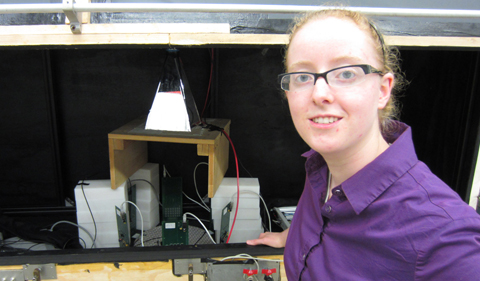
Natalie Klco standing in front of an LED light calibration setup at the National Institute of Nuclear Physics Section of Genoa, Italy
Junior Natalie Klco’15 HTC Physics major spent this summer in Italy and France participating in two projects under the direction of Dr. Kenneth Hicks, a professor in the Department of Physics and Astronomy. Hicks is a member of a team of researchers conducting a tracking detector experiment at the Thomas Jefferson National Accelerator Facility (Jefferson Lab) in Newport News, Virginia. He is the principle investigator on a grant from the National Science Foundation to purchase the tracking detector from Saclay Nuclear Research Centre (CEA/Saclay) located in France. At CEA/Saclay, French researchers have developed new technology to do particle tracking at high rates.
“Natalie began her summer in Genoa, Italy where she worked on the Forward Tagger project, supervised by Drs. Raffaella DeVita and Marco Battaglieri, researchers at the National Institute of Nuclear Physics Section of Genoa,” Hicks explained. “The Forward Tagger project involves designing hardware to detect electron scattering inside the CLAS12 spectrometer, a detector under construction for the Jefferson Lab. Once the Forward Tagger is installed in the CLAS12 detector at Jefferson Lab, it will be possible to investigate the kinds of particles that can be formed from quarks when high-energy electrons are scattered from protons and neutrons.”
“After spending a month in Italy,” Hicks continued, “Natalie traveled to CEA/Saclay, to participate in a second month-long project, under the supervision of Drs. Franck Sabatie and Sebastien Procureur. She assisted in the testing and documentation of a new style of detector that will track particles produced in CLAS12 particle physics experiment also at Jefferson Lab. Natalie studied the calibration and temperature stability of an LED array that will be used to monitor light output of high-energy electron detectors. She also learned throughout the summer how radiation detectors are built and tested.”
Below is Natalie’s reflection on her summer experiences.
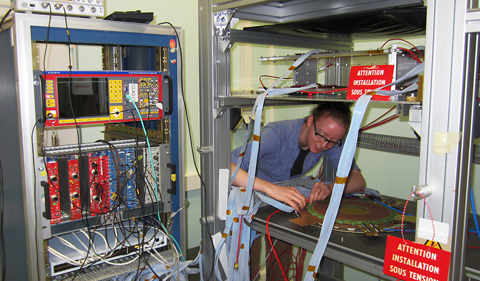
The detector at CEA/Saclay (in France) is a round disk with a hole in the center. It has six electronics boards attached that amplify the electric signal from a high-energy particle that passes through the detector and transmits information to computer readout. The equipment to supply voltage to the detector and the interface to the computer are shown in the background.
Spanning Two Continents and Two Disciplines to Explore the Sublime
By Natalie Klco
Last summer, after traveling west across the continental United States to attend and perform in the Zeltsman Marimba Festival in Arcata, California, I wrote about the beauty I found in marimba music and festival performers who displayed clarity and oneness between their instruments, their bodies, and their minds.
This summer I headed east across the Atlantic to Italy and France, where a world of similar beauty revealed itself to me in the field of nuclear physics. I participated in physics experiments with scientists whose relationships with the world are developing deeper with each new discovery.
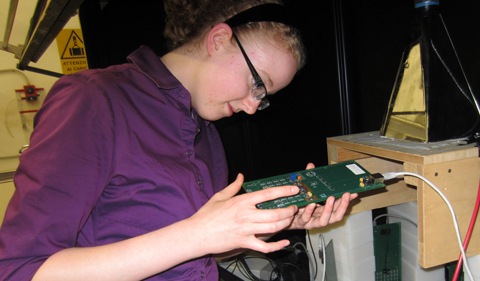
Examining an electronics board that controls the LED pulsing for the calibration setup in Genoa, Italy
Although my parents report that a much younger version of myself came running home from middle school one day to announce that she had “figured out math…mastered it and all of its ramifications,” the current version of myself has shifted to a continuous state of awe with the realization that there is so much more to discover about ourselves and the universe. Learning, I’ve discovered, does not end with mastery and mastery is often defined differently in the eyes of the beholder.
At the end of the day, though, we do not practice and study for the sole sake of performing and publishing because the final products of these works may be short-lived in comparison to the dedication and discipline required preparing them. And though we revel in the moments that we share a part of ourselves with the larger community, we wake up every day for the intimacy and purity that comes with an indulgence in the unknown.
Dr. Hicks and the European physicists of the National Institute of Nuclear Physics Section of Genoa in Italy, and the Saclay Nuclear Research Center (CEA Saclay) in France, provided the opportunity to experience this sense of life, the immense vitality of which has been almost unbearable…though I think I will manage.


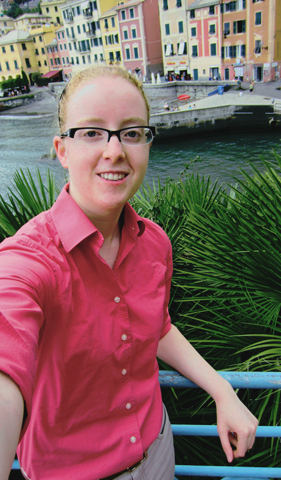

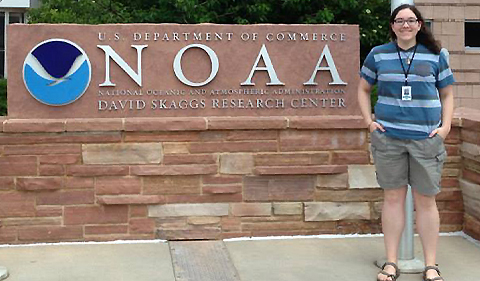















Comments